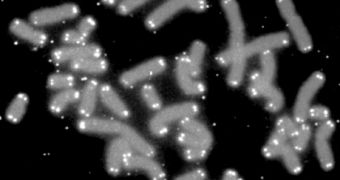Genetics may soon provide us with a means of finding out how long each individual on this planet will live, as soon as they are born. In a new study, experts found that the length of cellular components called telomeres can be used to predict human lifespan.
Telomeres are structures located at the end of chromosomes, and their role is to act like a protective cap of sorts. Every time the chromosomes duplicate, the length of telomeres shortens by a small margin.
This shortening is accompanied by the loss of DNA fragments. With each successful mitosis (cellular division), telomeres get shorter and shorter, and eventually give way. The rate at which this process occurs and the original length of the protective structures can therefore be used to predict lifespan.
This research was carried out by a team of experts at the University of Glasgow and University of Exeter, both in the United Kingdom. Thus far, they have only been able to use telomere analysis to predict the lifespan of individual zebra finches, a type of bird.
This species “has the potential to live for a relatively long time, shows considerable variation in lifespan within a single captive population and is easy to keep and breed,” explains the leader of the new investigation, Glasgow professor Pat Monaghan.
But the team is convinced that additional investigations will lead to similar capabilities for humans.
One of the reasons telomeres are so important for mitosis is that their main role is to protect “vital” DNA strands located within the chromosomes. With each duplication, small segments of genetic material are lost, but they are not taken from the chromosomes, but from their protective caps.
What this does is enable each cell to divide successfully – and error-free – for the longest period of time possible. When the telomeres become too short, they can no longer ensure that errors don't make their way into new chromosomes following duplication.
According to the conclusions of past investigations, it would appear that the enzyme telomerase plays a role in averting the shortening of telomeres, by adding new DNA fragments to the protective structures.
Unfortunately, animals such as humans lose their ability to use telomerase after developing beyond the embryonic stage. But this discovery could be used to develop new therapies meant to keep telomeres going for as long as possible.
In fact, some scientists believe that this is one of the approaches that may lead to prolonging the average span of human life. In effect, they are talking about a cure for old age. However, that application is many decades away, Science Blog reports.

 14 DAY TRIAL //
14 DAY TRIAL //